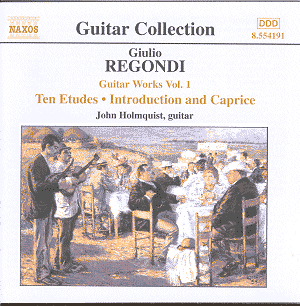Giulio REGONDI (1822-1872)
1. INTRODUCTION ET CAPRICE
Adagio - Allegretto scherzando
TEN ETUDES
2. Etude No.1: Moderato
3. Etude No.2: Andante con moto
4. Etude No.3: Allegro con moto
5. Etude No.4: Adagio cantabile
6. Etude No.5: Allegretto
7. Etude No.6: Andante
8. Etude No.7: Allegretto
9. Etude No.8: Allegretto con moto ben marcato la melodia
10. Etude No.9: Larghetto
11. Etude No.10: Allegro moderato
12. FETE VILLAGEOISE: RONDO
CAPRICE
 John Holmquist - Guitar John Holmquist - Guitar
 NAXOS 8.554191 [58:12] NAXOS 8.554191 [58:12] |
 |
| Crotchet
AmazonUK
AmazonUS
Amazon
recommendations |
Giulio Regondi is from that generation of guitarists that followed
what might be described as a golden period in the history of the instrument,
that is the years of Fernando Sor (1778-1739) and Mauro Giuliani (1781- 1829),
when the guitar was immensely fashionable, especially in the major cities
of Europe. Influenced and inspired by their predecessor's classicism this
new generation, which included Regondi, Napoleon Coste (1805-1883) and Johann
Kasper Mertze (1806-1856) among others, was to bring the guitar into the
Romantic era.
Details of Regondi's birth are vague, it is not clear whether he was born
in Geneva or Genoa, or if his mother, who was allegedly German, died giving
birth to him. However it is known that he was taught the guitar by his father
and gained a reputation as a child prodigy. By the age of 11 or 12 he was
touring Europe with his father and getting favourable reviews, one of which
described him as the "Enfant Paganini". (See Classical Guitar magazine March
2000 Volume18, No. 7 "Regondi in Ireland" by Thomas Lawrence). He was unusual
in as much that unlike many concert-giving composers who only played their
own compositions Regondi would also include along with his own works pieces
by Sor and Giuliani etc.
Regondi's compositions show the development of music from the Classical into
the Romantic period with its more adventurous use of harmony and modulation,
which is evident in his "Ten Etudes". The harmonic progressions are not only
unpredictable but also for their time, in guitaristic terms, surprising.
But having said that although the music has a certain appeal there is no
great variety of mood other than that offered by the use of Major or minor
keys and speed variations.
The "Introduction et Caprice" as with most of the pieces on this disc, show
the virtuosic element in Regondi's music with chromatic runs, rapid scale
passage's in octaves and sliding glissandos etc that tests the technical
skills of the guitarist. The guitarist on this recording being John Holmquist,
who regularly records for Naxos, as always presents a fine involved performance
of all the works here.
This disc, and composer are welcome additions to what is becoming the Naxos
encyclopaedia of composers of classical guitar music.
Andy Daly

